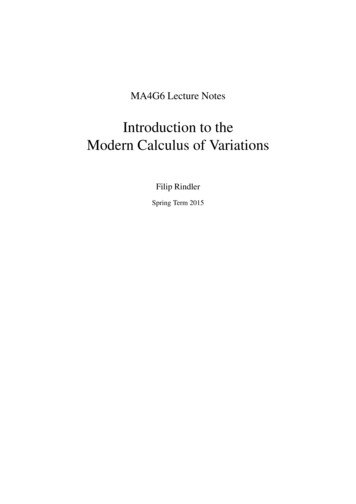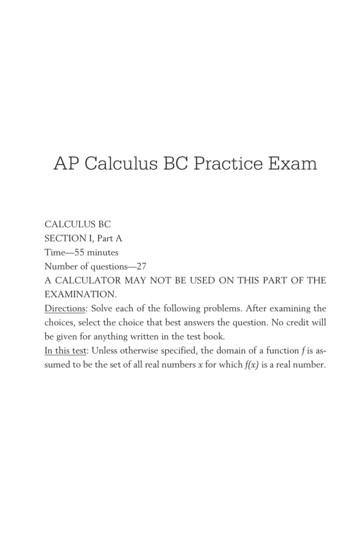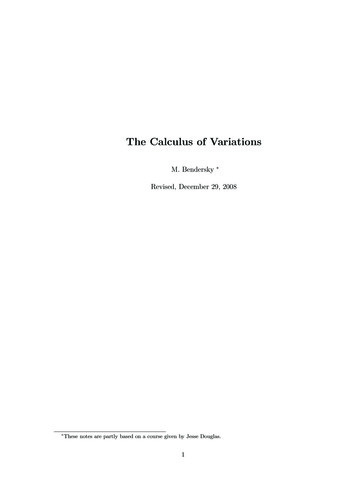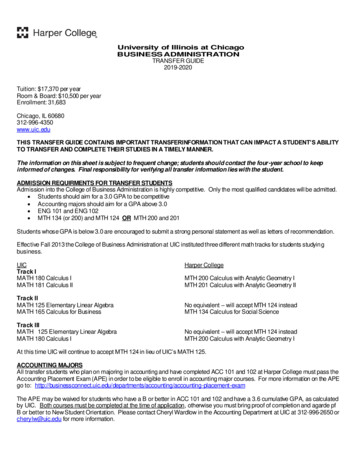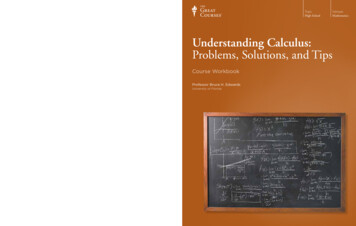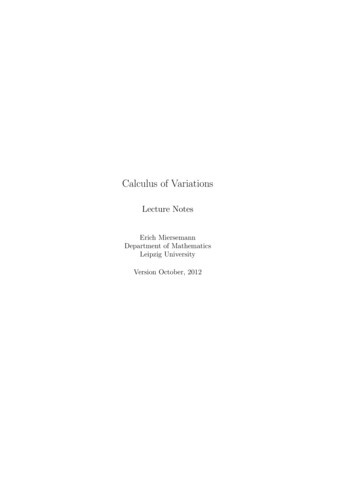
Transcription
Calculus of VariationsLecture NotesErich MiersemannDepartment of MathematicsLeipzig UniversityVersion October, 2012
2
Contents1 Introduction1.1 Problems in Rn . . . . . . . . . . . . . . . . . .1.1.1 Calculus . . . . . . . . . . . . . . . . . .1.1.2 Nash equilibrium . . . . . . . . . . . . .1.1.3 Eigenvalues . . . . . . . . . . . . . . . .1.2 Ordinary differential equations . . . . . . . . .1.2.1 Rotationally symmetric minimal surface1.2.2 Brachistochrone . . . . . . . . . . . . .1.2.3 Geodesic curves . . . . . . . . . . . . . .1.2.4 Critical load . . . . . . . . . . . . . . .1.2.5 Euler’s polygonal method . . . . . . . .1.2.6 Optimal control . . . . . . . . . . . . . .1.3 Partial differential equations . . . . . . . . . . .1.3.1 Dirichlet integral . . . . . . . . . . . . .1.3.2 Minimal surface equation . . . . . . . .1.3.3 Capillary equation . . . . . . . . . . . .1.3.4 Liquid layers . . . . . . . . . . . . . . .1.3.5 Extremal property of an eigenvalue . . .1.3.6 Isoperimetric problems . . . . . . . . . .1.4 Exercises . . . . . . . . . . . . . . . . . . . . .2 Functions of n variables2.1 Optima, tangent cones . . . .2.1.1 Exercises . . . . . . .2.2 Necessary conditions . . . . .2.2.1 Equality constraints .2.2.2 Inequality constraints2.2.3 Supplement . . . . . .2.2.4 Exercises . . . . . . 9525658
4CONTENTS2.3. 59. 61. 62. 64. 65. 71. 72. 72. 73. 73. 77. 79. 83. 90. 90. 94. 96. 98. 101. 1033 Ordinary differential equations3.1 Optima, tangent cones, derivatives . . .3.1.1 Exercises . . . . . . . . . . . . .3.2 Necessary conditions . . . . . . . . . . .3.2.1 Free problems . . . . . . . . . . .3.2.2 Systems of equations . . . . . . .3.2.3 Free boundary conditions . . . .3.2.4 Transversality conditions . . . .3.2.5 Nonsmooth solutions . . . . . . .3.2.6 Equality constraints; functionals3.2.7 Equality constraints; functions .3.2.8 Unilateral constraints . . . . . .3.2.9 Exercises . . . . . . . . . . . . .3.3 Sufficient conditions; weak minimizers .3.3.1 Free problems . . . . . . . . . . .3.3.2 Equality constraints . . . . . . .3.3.3 Unilateral constraints . . . . . .3.3.4 Exercises . . . . . . . . . . . . .3.4 Sufficient condition; strong minimizers .2.42.52.62.7Sufficient conditions . . . . . . . . . .2.3.1 Equality constraints . . . . . .2.3.2 Inequality constraints . . . . .2.3.3 Exercises . . . . . . . . . . . .Kuhn-Tucker theory . . . . . . . . . .2.4.1 Exercises . . . . . . . . . . . .Examples . . . . . . . . . . . . . . . .2.5.1 Maximizing of utility . . . . . .2.5.2 V is a polyhedron . . . . . . .2.5.3 Eigenvalue equations . . . . . .2.5.4 Unilateral eigenvalue problems2.5.5 Noncooperative games . . . . .2.5.6 Exercises . . . . . . . . . . . .Appendix: Convex sets . . . . . . . . .2.6.1 Separation of convex sets . . .2.6.2 Linear inequalities . . . . . . .2.6.3 Projection on convex sets . . .2.6.4 Lagrange multiplier rules . . .2.6.5 Exercises . . . . . . . . . . . .References . . . . . . . . . . . . . . . 55162164
CONTENTS3.553.4.1 Exercises . . . . . . . . . . . . . . . . . . . . . . . . . 169Optimal control . . . . . . . . . . . . . . . . . . . . . . . . . . 1703.5.1 Pontryagin’s maximum principle . . . . . . . . . . . . 1713.5.2 Examples . . . . . . . . . . . . . . . . . . . . . . . . . 1713.5.3 Proof of Pontryagin’s maximum principle; free endpoint1763.5.4 Proof of Pontryagin’s maximum principle; fixed endpoint . . . . . . . . . . . . . . . . . . . . . . . . . . . . 1793.5.5 Exercises . . . . . . . . . . . . . . . . . . . . . . . . . 185
6CONTENTS
PrefaceThese lecture notes are intented as a straightforward introduction to thecalculus of variations which can serve as a textbook for undergraduate andbeginning graduate students.The main body of Chapter 2 consists of well known results concerningnecessary or sufficient criteria for local minimizers, including Lagrange multiplier rules, of real functions defined on a Euclidean n-space. Chapter 3concerns problems governed by ordinary differential equations.The content of these notes is not encyclopedic at all. For additionalreading we recommend following books: Luenberger [36], Rockafellar [50]and Rockafellar and Wets [49] for Chapter 2 and Bolza [6], Courant andHilbert [9], Giaquinta and Hildebrandt [19], Jost and Li-Jost [26], Sagan [52],Troutman [59] and Zeidler [60] for Chapter 3. Concerning variational problems governed by partial differential equations see Jost and Li-Jost [26] andStruwe [57], for example.7
8CONTENTS
Chapter 1IntroductionA huge amount of problems in the calculus of variations have their originin physics where one has to minimize the energy associated to the problemunder consideration. Nowadays many problems come from economics. Hereis the main point that the resources are restricted. There is no economywithout restricted resources.Some basic problems in the calculus of variations are:(i) find minimizers,(ii) necessary conditions which have to satisfy minimizers,(iii) find solutions (extremals) which satisfy the necessary condition,(iv) sufficient conditions which guarantee that such solutions are minimizers,(v) qualitative properties of minimizers, like regularity properties,(vi) how depend minimizers on parameters?,(vii) stability of extremals depending on parameters.In the following we consider some examples.1.11.1.1Problems in RnCalculusLet f : V 7 R, where V Rn is a nonempty set. Consider the problemx V : f (x) f (y) for all y V.If there exists a solution then it follows further characterizations of thesolution which allow in many cases to calculate this solution. The main tool9
10CHAPTER 1. INTRODUCTIONfor obtaining further properties is to insert for y admissible variations of x.As an example let V be a convex set. Then for given y Vf (x) f (x ²(y x))for all real 0 ² 1. From this inequality one derives the inequalityh f (x), y xi 0 for all y V,provided that f C 1 (Rn ).1.1.2Nash equilibriumIn generalization to the above problem we consider two real functions fi (x, y),i 1, 2, defined on S1 S2 , where Si Rmi . An (x , y ) S1 S2 is calleda Nash equilibrium iff1 (x, y ) f1 (x , y ) for all x S1f2 (x , y) f2 (x , y ) for all y S2 .The functions f1 , f2 are called payoff functions of two players and the setsS1 and S2 are the strategy sets of the players. Under additional assumptionson fi and Si there exists a Nash equilibrium, see Nash [46]. In Section 2.4.5we consider more general problems of noncooperative games which play animportant role in economics, for example.1.1.3EigenvaluesConsider the eigenvalue problemAx λBx,where A and B are real and symmetric matrices with n rows (and n columns).Suppose that hBy, yi 0 for all y Rn \ {0}, then the lowest eigenvalue λ1is given byhAy, yi.λ1 miny Rn \{0} hBy, yiThe higher eigenvalues can be characterized by the maximum-minimumprinciple of Courant, see Section 2.5.In generalization, let C Rn be a nonempty closed convex cone with vertexat the origin. Assume C 6 {0}. Then, see [37],hAy, yiy C\{0} hBy, yiλ1 min
1.2. ORDINARY DIFFERENTIAL EQUATIONS11is the lowest eigenvalue of the variational inequalityx C : hAx, y xi λhBx, y xi for all y C.Remark. A set C Rn is said to be a cone with vertex at x if for anyy C it follows that x t(y x) C for all t 0.1.2Ordinary differential equationsSetZE(v) bf (x, v(x), v 0 (x)) dxaand for given ua , ub RV {v C 1 [a, b] : v(a) ua , v(b) ub },where a b and f is sufficiently regular. One of the basicproblems in the calculus of variation is(P )minv V E(v).That is, we seek au V : E(u) E(v) for all v V.Euler equation. Let u V be a solution of (P) and assume additionallyu C 2 (a, b), thendfu0 (x, u(x), u0 (x)) fu (x, u(x), u0 (x))dxin (a, b).Proof. Exercise. Hints: For fixed φ C 2 [a, b] with φ(a) φ(b) 0 andreal ², ² ²0 , set g(²) E(u ²φ). Since g(0) g(²) it follows g 0 (0) 0.Integration by parts in the formula for g 0 (0) and the following basic lemmain the calculus of variations imply Euler’s equation.2
12CHAPTER 1. INTRODUCTIONyubuaabxFigure 1.1: Admissible variationsBasic lemma in the calculus of variations. Let h C(a, b) andZbh(x)φ(x) dx 0afor all φ C01 (a, b). Then h(x) 0 on (a, b).Proof. Assume h(x0 ) 0 for an x0 (a, b), then there is a δ 0 such that(x0 δ, x0 δ) (a, b) and h(x) h(x0 )/2 on (x0 δ, x0 δ). Set½ ¡ 2δ 2 x x0 2if x (x0 δ, x0 δ)φ(x) .0 if x (a, b) \ [x0 δ, x0 δ]Thus φ C01 (a, b) andZbah(x0 )h(x)φ(x) dx 2Zx0 δφ(x) dx 0,x0 δwhich is a contradiction to the assumption of the lemma.1.2.12Rotationally symmetric minimal surfaceConsider a curve defined by v(x), 0 x l, which satisfies v(x) 0 on [0, l]and v(0) a, v(l) b for given positive a and b, see Figure 1.2. Let S(v)
131.2. ORDINARY DIFFERENTIAL EQUATIONSbSalxFigure 1.2: Rotationally symmetric surfacebe the surface defined by rotating the curve around the x-axis. The area ofthis surface isZ lp S(v) 2πv(x) 1 (v 0 (x))2 dx.0SetV {v C 1 [0, l] : v(0) a, v(l) b, v(x) 0 on (a, b)}.Then the variational problem which we have to consider ismin S(v) .v VSolutions of the associated Euler equation are catenoids ( chain curves),see an exercise.1.2.2BrachistochroneIn 1696 Johann Bernoulli studied the problem of a brachistochrone to finda curve connecting two points P1 and P2 such that a mass point moves fromP1 to P2 as fast as possible in a downward directed constant gravitionalfield, see Figure 1.3. The associated variational problem is hereZ t2 p 0 2x (t) y 0 (t)2pmindt ,(x,y) V t1y(t) y1 kwhere V is the set of C 1 [t1 , t2 ] curves defined by (x(t), y(t)), t1 t t2 , withx0 (t)2 y 0 (t)2 6 0, (x(t1 ), y(t1 )) P1 , (x(t2 ), y(t2 )) P2 and k : v12 /2g,where v1 is the absolute value of the initial velocity of the mass point, andy1 : y(t1 ). Solutions are cycloids (German: Rollkurven), see Bolza [6]
14CHAPTER 1. INTRODUCTIONxP1gmP2yFigure 1.3: Problem of a brachistochroneand Chapter 3. These functions are solutions of the system of the Eulerdifferential equations associated to the above variational problem.One arrives at the above functional which we have to minimize sinceqpv 2g(y y1 ) v12 , v ds/dt, ds x1 (t)2 y 0 (t)2 dtandT Zt2t1dt Zt2t1ds,vwhere T is the time which the mass point needs to move from P1 to P2 .1.2.3Geodesic curvesConsider a surface S in R3 , two points P1 , P2 on S and a curve on Sconnecting these points, see Figure 1.4. Suppose that the surface S is definedby x x(v), where x (x1 , x2 , x3 ) and v (v1 , v2 ) and v U R2 .Consider curves v(t), t1 t t2 , in U such that v C 1 [t1 , t2 ] and v10 (t)2 v20 (t)2 6 0 on [t1 , t2 ], and defineV {v C 1 [t1 , t2 ] : x(v(t1 )) P1 , x(v(t2 )) P2 }.The length of a curve x(v(t)) for v V is given byZ t2 rdx(v(t)) dx(v(t))·dt.L(v) dtdtt1Set E xv1 · xv1 , F xv1 · xv2 , G xv2 · xv2 . The functions E, F and Gare called coefficients of the first fundamental form of Gauss. Then we getfor the length of the cuve under considerationZ t2 qL(v) E(v(t))v10 (t)2 2F (v(t))v10 (t)v20 (t) G(v(t))v20 (t)2 dtt1
151.2. ORDINARY DIFFERENTIAL EQUATIONSx3PS2P1x2x1Figure 1.4: Geodesic curvesand the associated variational problem to study is heremin L(v).v VFor examples of surfaces (sphere, ellipsoid) see [9], Part II.1.2.4Critical loadConsider the problem of the critical Euler load P for a beam. This value isgiven bya(v, v)P min,V \{0} b(v, v)whereZlu00 (x)v 00 (x) dxa(u, v) EI0Z 2b(u, v) u0 (x)v 0 (x) dx0andE modulus of elasticity,I surface moment of inertia, EI is called bending stiffness,V is the set of admissible deflections defined by the prescribed conditions atthe ends of the beam. In the case of a beam simply supported at both ends,see Figure 1.5(a), we have
16CHAPTER 1. INTRODUCTIONPPvlvl(a)(b)Figure 1.5: Euler load of a beamV {v C 2 [0, l] : v(0) v(l) 0}which leads to the critical value P EIπ 2 /l2 . If the beam is clamped atthe lower end and free (no condition is prescribed) at the upper end, seeFigure 1.5(b), thenV {v C 2 [0, l] : v(0) v 0 (0) 0},and the critical load is here P EIπ 2 /(4l2 ).Remark. The quotient a(v, v)/b(v, v) is called Rayleigh quotient (LordRayleigh, 1842-1919).Example: Summer houseAs an example we consider a summer house based on columns, see Figure 1.6:9 columns of pine wood, clamped at the lower end, free at the upper end,9 cm 9 cm is the cross section of each column,2,5 m length of a column,9 - 16 · 109 N m 2 modulus of elasticity, parallel fiber,0.6 - 1 · 109 N m 2 modulus of elasticity, perpendicular fiber,Z ZI x2 dxdy, Ω ( 4.5, 4.5) ( 4.5, 4.5),Ω
1.2. ORDINARY DIFFERENTIAL EQUATIONS17I 546.75 · 10 8 m4 ,E : 5 109 N m 2 ,P 10792 N, m 1100 kg (g: 9.80665 ms 2 ),9 columns: 9900 kg,18 m2 area of the flat roof,10 cm wetted snow: 1800 kg.Figure 1.6: Summer house constructionUnilateral bucklingIf there are obstacles on both sides, see Figure 1.7, then we have in the caseof a beam simply supported at both endsV {v C 2 [0, l] : v(0) v(l) 0 and φ1 (x) v(x) φ2 (x) on (0, l)}.The critical load is hereP infV \{0}a(v, v).b(v, v)It can be shown, see [37, 38], that this number P is the lowest point ofbifurcation of the eigenvalue variational inequalityu V : a(u, v u) λb(u, v u) for all v V.
18CHAPTER 1. INTRODUCTIONPvlxFigure 1.7: Unilateral beamA real λ0 is said to be a point of bifurcation of the the above inequality ifthere exists a sequence un , un 6 0, of solutions with associated eigenvaluesλn such that un 0 uniformly on [0, l] and λn λ0 .Optimal design of a columnConsider a rotationally symmetric column, see Figure 1.8. Letl be the length of the column,r(x) radius of the cross section,I(x) π(r(x))4 /4 surface moment of inertia,ρ constant density of the material,E modulus of elasticity.Seta(r)(u, v) Zl0b(r)(v, v) Zl4ρr(x) u (x)v (x) dx E4 0000Z l µZ0xl2¶r(t) dt u0 (x)v 0 (x) dxu0 (x)v 0 (x) dx.0Suppose that ρ/E is sufficiently small to avoid that the column is unstablewithout any load P . If the column is clamped at the lower end and free at
1.2. ORDINARY DIFFERENTIAL EQUATIONS19xPr(x)Figure 1.8: Optimal design of a columnthe upper end, then we setV {v C 2 [0, l] : v(0) v 0 (0) 0}and consider the Rayleigh quotientq(r, v) a(r)(v, v).b(r)(v, v)We seek an r such that the critical load P (r) Eπλ(r)/4, whereλ(r) min q(r, v),v V \{0}approaches its infimum in a given set U of functions, for exampleZ lr(x)2 dx M },U {r C[a, b] : r0 r(x) r1 , π0where r0 , r1 are given positive constants and M is the given volume of thecolumn. That is, we consider the saddle point problemµ¶min q(r, v) .maxr Uv V \{0}Let (r0 , v0 ) be a solution, thenq(r, v0 ) q(r0 , v0 ) q(r0 , v)for all r U and for all v V \ {0}.
201.2.5CHAPTER 1. INTRODUCTIONEuler’s polygonal methodConsider the functionalE(v) Zbf (x, v(x), v 0 (x)) dx,awhere v V withV {v C 1 [a, b] : v(a) A, v(b) B}with given A, B. Leta x0 x1 . . . xn xn 1 bbe a subdivision of the interval [a, b]. Then we replace the graph definedby v(x) by the polygon defined by (x0 , A), (x1 , v1 ), . , (xn , vn ), (xn 1 , B),where vi v(xi ), see Figure 1.9. Set hi xi xi 1 and v (v1 , . . . , vn ),vabxFigure 1.9: Polygonal methodand replace the above integral bye(v) n 1Xi 1µ¶vi vi 1f xi , vi ,hi .hiThe problem minv Rn e(v) is an associated finite dimensional problem tominv V E(v). Then one shows, under additional assumptions, that the finitedimensional problem has a solution which converges to a solution to theoriginal problem if n .Remark. The historical notation ”problems with infinitely many variables”for the above problem for the functional E(v) has its origin in Euler’s polygonal method.
1.2. ORDINARY DIFFERENTIAL EQUATIONS1.2.621Optimal controlAs an example for problems in optimal control theory we mention here aproblem governed by ordinary differential equations. For a given functionv(t) U Rm , t0 t t1 , we consider the boundary value problemy 0 (t) f (t, y(t), v(t)), y(t0 ) x0 , y(t1 ) x1 ,where y Rn , x0 , x1 are given, andf : [t0 , t1 ] Rn Rm 7 Rn .In general, there is no solution of such a problem. Therefore we considerthe set of admissible controls Uad defined by the set of piecewise continuousfunctions v on [t0 , t1 ] such that there exists a solution of the boundary valueproblem. We suppose that this set is not empty. Assume a cost functionalis given byZ t1E(v) f 0 (t, y(t)), v(t)) dt,t0wheref 0 : [t0 , t1 ] Rn Rm 7 R,v Uad and y(t) is the solution of the above boundary value problem withthe control v.The functions f, f 0 are assumed to be continuous in (t, y, v) and continuously differentiable in (t, y). It is not required that these functions aredifferentiable with respect to v.Then the problem of optimal control ismax E(v).v UadA piecewise continuous solution u is called optimal control and the solutionx of the associated system of boundary value problems is said to be optimaltrajectory.The governing necessary condition for this type of problems is the Pontryagin maximum principle, see [48] and Section 3.5.
221.3CHAPTER 1. INTRODUCTIONPartial differential equationsThe same procedure as above applied to the following multiple integral leadsto a second-order quasilinear partial differential equation. SetZF (x, v, v) dx,E(v) Ωwhere Ω Rn is a domain, x (x1 , . . . , xn ), v v(x) : Ω 7 R, and v (vx1 , . . . , vxn ). It is assumed that the function F is sufficiently regularin its arguments. For a given function h, defined on Ω, setV {v C 1 (Ω) : v h on Ω}.Euler equation. Let u V be a solution of (P), and additionally u C 2 (Ω), thennX Fu Fu xi xii 1in Ω.Proof. Exercise. Hint: Extend the above fundamental lemma of the calculusof variations to the case of multiple integrals. The interval (x0 δ, x0 δ) inthe definition of φ must be replaced by a ball with center at x0 and radiusδ.21.3.1Dirichlet integralIn two dimensions the Dirichlet integral is given byZ ¡ 2vx vy2 dxdyD(v) Ωand the associated Euler equation is the Laplace equation 4u 0 in Ω.Thus, there is natural relationship between the boundary value problem4u 0 in Ω, u h on Ωand the variational problemmin D(v).v V
1.3. PARTIAL DIFFERENTIAL EQUATIONS23But these problems are not equivalent in general. It can happen that theboundary value problem has a solution but the variational problem has nosolution. For an example see Courant and Hilbert [9], Vol. 1, p. 155, whereh is a continuous function and the associated solution u of the boundaryvalue problem has no finite Dirichlet integral.The problems are equivalent, provided the given boundary value functionh is in the class H 1/2 ( Ω), see Lions and Magenes [35].1.3.2Minimal surface equationThe non-parametric minimal surface problem in two dimensions is to find aminimizer u u(x1 , x2 ) of the problemZ qmin1 vx21 vx22 dx,v VΩwhere for a given function h defined on the boundary of the domain ΩV {v C 1 (Ω) : v h on Ω}.Suppose that the minimizer satisfies the regularity assumption u C 2 (Ω),SΩFigure 1.10: Comparison surfacethen u is a solution of the minimal surface equation (Euler equation) in ΩÃÃ!!u x1u x2 pp 0. x1 x21 u 21 u 2
24CHAPTER 1. INTRODUCTIONIn fact, the additional assumption u C 2 (Ω) is superfluous since it followsfrom regularity considerations for quasilinear elliptic equations of secondorder, see for example Gilbarg and Trudinger [20].Let Ω R2 . Each linear function is a solution of the minimal surfaceequation. It was shown by Bernstein [4] that there are no other solutions ofthe minimal surface equation. This is true also for higher dimensions n 7,see Simons [56]. If n 8, then there exists also other solutions which definecones, see Bombieri, De Giorgi and Giusti [7].The linearized minimal surface equation over u 0 is the Laplace equation 4u 0. In R2 linear functions are solutions but also many otherfunctions in contrast to the minimal surface equation. This striking difference is caused by the strong nonlinearity of the minimal surface equation.More general minimal surfaces are described by using parametric representations. An example is shown in Figure 1.111 . See [52], pp. 62, forexample, for rotationally symmetric minimal surfaces, and [47, 12, 13] formore general surfaces. Suppose that the surface S is defined by y y(v),Figure 1.11: Rotationally symmetric minimal surfacewhere y (y1 , y2 , y3 ) and v (v1 , v2 ) and v U R2 . The area of thesurface S is given byZ p S(y) EG F 2 dv,U1An experiment from Beutelspacher’s Mathematikum, Wissenschaftsjahr 2008, Leipzig
251.3. PARTIAL DIFFERENTIAL EQUATIONSwhere E yv1 · yv1 , F yv1 · yv2 , G yv2 · yv2 are the coefficients of thefirst fundamental form of Gauss. Then an associated variational problem ismin S(y) ,y Vwhere V is a given set of comparison surfaces which is defined, for example,by the condition that y( U ) Γ, where Γ is a given curve in R3 , seeFigure 1.12. Set V C 1 (Ω) andx3Sx2x1Figure 1.12: Minimal surface spanned between two ringsE(v) ZΩZF (x, v, v) dx g(x, v) ds, Ωwhere F and g are given sufficiently regular functions and Ω Rn is abounded and sufficiently regular domain. Assume u is a minimizer of E(v)in V , that is,u V : E(u) E(v) for all v V,thenZΩn¡Xi 1Fuxi (x, u, u)φxi Fu (x, u, u)φ dx Z Ωgu (x, u)φ ds 0
26CHAPTER 1. INTRODUCTIONfor all φ C 1 (Ω). Assume additionally that u C 2 (Ω), then u is a solutionof the Neumann type boundary value problemnX Fu xi xi Fu in Ωi 1nXFuxi νi gu on Ω,i 1where ν (ν1 , . . . , νn ) is the exterior unit normal at the boundary Ω. Thisfollows after integration by parts from the basic lemma of the calculus ofvariations.SetZZ12E(v) v dx h(x)v ds,2 Ω Ωthen the associated boundary value problem is4u 0 in Ω u h on Ω. ν1.3.3Capillary equationLet Ω R2 and setZZZ pκ22v ds.v dx cos γ1 v dx E(v) 2 Ω ΩΩHere is κ a positive constant (capillarity constant) and γ is the (constant)boundary contact angle, that is, the angle between the container wall andthe capillary surface, defined by v v(x1 , x2 ), at the boundary. Then therelated boundary value problem isdiv (T u) κu in Ων · T u cos γ on Ω,where we use the abbreviation uTu p,1 u 2div (T u) is the left hand side of the minimal surface equation and it is twicethe mean curvature of the surface defined by z u(x1 , x2 ), see an exercise.
1.3. PARTIAL DIFFERENTIAL EQUATIONS27The above problem describes the ascent of a liquid, water for example,in a vertical cylinder with constant cross section Ω. It is assumed thatthe gravity is directed downwards in the direction of the negative x3 axis.Figure 1.13 showsthat liquid can rise along a vertical wedge. This is a consequence of the strong nonlinearity of the underlying equations, see Finn [16].This photo was taken from [42].Figure 1.13: Ascent of liquid in a wedgeThe above problem is a special case (graph solution) of the followingproblem. Consider a container partially filled with a liquid, see Figure 1.14.Suppose that the associate energy functional is given byZE(S) σ S σβ W (S) Y ρ dx,Ωl (S)whereY potential energy per unit mass, for example Y gx3 , g const. 0,ρ local density,σ surface tension, σ const. 0,β (relative) adhesion coefficient between the fluid and the container wall,W wetted part of the container wall,Ωl domain occupied by the liquid.Additionally we have for given volume V of the liquid the constraint Ωl (S) V.
28CHAPTER 1. ure 1.14: Liquid in a containerIt turns out that a minimizer S0 of the energy functional under the volumeconstraint satisfies, see [16],2σH λ gρx3 on S0cos γ β on S0 ,where H is the mean curvature of S0 and γ is the angle between the surfaceS0 and the container wall at S0 .Remark. The term σβ W in the above energy functional is called wettingenergy.Figure 1.15: Piled up of liquid
1.3. PARTIAL DIFFERENTIAL EQUATIONS29Liquid can pilled up on a glass, see Figure 1.15. This picture was takenfrom [42]. Here the capillary surface S satisfies a variational inequality at S where S meets the container wall along an edge, see [41].1.3.4Liquid layersPorous materials have a large amount of cavities different in size and geometry. Such materials swell and shrink in dependence on air humidity. Herewe consider an isolated cavity, see [54] for some cavities of special geometry.Let Ωs R3 be a domain occupied by homogeneous solid material. Thequestion is whether or not liquid layers Ωl on Ωs are stable, where Ωv isthe domain filled with vapour and S is the capillary surface which is theinterface between liquid and vapour, see Figure 1.16.ΩssolidΩlliquidSNΩvvapourFigure 1.16: Liquid layer in a poreLetE(S) σ S w(S) µ Dl (S) (1.1)be the energy (grand canonical potential) of the problem, whereσ surface tension, S , Ωl (S) denote the area resp. volume of S, Ωl (S),Zw(S) F (x) dx ,(1.2)Ωv (S)is the disjoining pressure potential, whereZdyF (x) c. x y pΩs(1.3)Here is c a negative constant, p 4 a positive constant (p 6 for nitrogen)and x R3 \ Ωs , where Ωs denotes the closure od Ωs , that is, the union of
30CHAPTER 1. INTRODUCTIONΩs with its boundary Ωs . Finally, setµ ρkT ln(X) ,whereρ density of the liquid,k Boltzmann constant,T absolute temperature,X reduced (constant) vapour pressure, 0 X 1.More precisely, ρ is the difference between the number densities of theliquid and the vapour phase. However, since in most practical cases thevapour density is rather small, ρ can be replaced by the density of the liquidphase.The above negative constant is given by c H/π 2 , where H is theHamaker constant, see [25], p. 177. For a liquid nitrogen film on quartz onehas about H 10 20 N m.Suppose that S0 defines a local minimum of the energy functional, then 2σH F µ 0 on S0 ,(1.4)where H is the mean curvature of S0 .A surface S0 which satisfies (1.4) is said to be an equilibrium state. Anexisting equilibrium state S0 is said to be stable by definition if· 2 dE(S(²)) 0d²2² 0for all ζ not identically zero, where S(²) is an appropriate one-parameterfamily of comparison surfaces.This inequality implies that1 F 0 on S0 ,(1.5)σ Nwhere K is the Gauss curvature of the capillary surface S0 , see Blaschke [5], p. 58,for the definition of K. 2(2H 2 K) 1.3.5Extremal property of an eigenvalueLet Ω R2 be a bounded and connected domain. Consider the eigenvalueproblem 4u λu in Ωu 0 on Ω.
1.3. PARTIAL DIFFERENTIAL EQUATIONS31It is known that the lowest eigenvalue λ1 (Ω) is positive, it is a simple eigenvalue and the associated eigenfunction has no zero in Ω. Let V be a set ofsufficiently regular domains Ω with prescribed area Ω . Then we considerthe problemmin λ1 (Ω).Ω VThe solution of this problem is a disk BR , R uniquely determined.1.3.6p Ω /π, and the solution isIsoperimetric problemsLet V be a set of all sufficiently regular bounded and connected domainsΩ R2 with prescribed length Ω of the boundary. Then we consider theproblemmax Ω .Ω VThe solution of this problem is a disk BR , R Ω /(2π), and the solutionis uniquely determined. This result follows by Steiner’s symmetrization,see [5], for example. From this method it follows that Ω 2 4π Ω 0if Ω is a domain different from a disk.Remark. Such an isoperimetric inequality follows also by using the inequalityZZ1 u 2 dx u dx 4π22RRfor all u C01 (R2 ). After an appropriate definition of the integral on theright hand side this inequality holds for functions from the Sobolev spaceH01 (Ω), see [1], or from the class BV (Ω), which are the functions of boundedvariation, see [15]. The set of characteristic functions for sufficiently regulardomains is contained in BV (Ω) and the square root of the integral of theright hand defines the perimeter of Ω. Set½1 : x Ωu χΩ 0 : x 6 Ωthen Ω 1 Ω 2 .4π
32CHAPTER 1. INTRODUCTIONThe associated problem in R3 ismax Ω ,Ω Vwhere V is the set of all sufficiently regular bounded and connected domainsΩ R3 with pprescribed perimeter Ω . The solution of this problem is aball BR , R Ω /(4π), and the solution is uniquely determined, see [5],for example, where it is shown that the isoperimetric inequality Ω 3 36π Ω 2 0holds for all sufficiently regular Ω, and equality holds only if Ω is a ball.
331.4. EXERCISES1.4Exercises1. Let V Rn be nonempty, closed and bounded and f : V 7 R lowersemicontinuous on V . Show that there exists an x V such thatf (x) f (y) for all y V .Hint: f : V 7 Rn is called lower semicontinuous on V if for everysequence xk x, xk , x V , it follows thatlim inf f (xk ) f (x).k 2. Let V Rn be the closure of a convex domain and assume f : V 7 Ris in C 1 (Rn ). Suppose that x V satisfies f (x) f (y) for all y V .Prove(i) h f (x), y xi 0 for all y V ,(ii) f (x) 0 if x is an interior point of V .3. Let A and B be real a
Chapter 1 Introduction A huge amount of problems in the calculus of variations have their origin in physics where one has to minimize the energy associated to the problem


